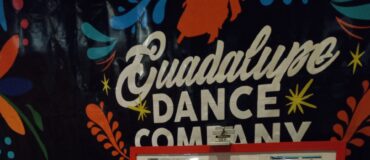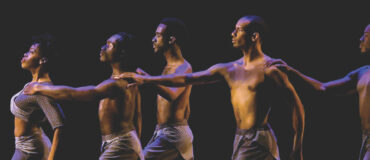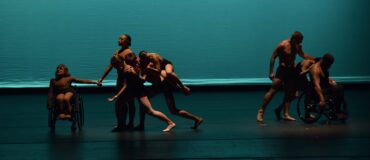By Lingyu Wang
Lingyu Wang is a 2022 Archiving and Preservation Fellow with Charya Burt Cambodian Dance. Read more about the Fellowships here. This is the fourth part of Lingyu’s blog. Read the third part here.
January 5, 2023: Making Archives Work for Everyone
Nena Gilreath from Ballethnic Dance Company said she felt it: The group was thinking together, and everyone was ready to make things happen, to make archives finally work for people. I thought it could not be more true.

Photo of Lingyu with archival technician Morgan, and Charya and Rob from Charya Burt Cambodian Dance Company at Dance/USA Connect: Denver 2022, outside conference hall.
This was towards the end of my stay at the Dance/USA Connect: Denver convening. In the afternoon on the second day of the conference, the Archiving and Preservation Fellowship cohort held our own informal gathering. The group included archival Fellows, as well as mentors, dancers, organizers, and scholars. Nena’s words hit a chord across the room. I have never been at a conference and felt everyone was so ready for things to happen. We were all working on different projects, with different dance cultures, materials, and heritages, yet we were all pushing things forward, in some shared direction. That is, we want to take the subject of archiving, a tradition so overwhelmed by white colonizer institutions, and make it work for more people.
The end of the summer for me turned out to be a rush. Fortunately, my work will continue with Charya Burt Cambodian Dance Company, and with all the amazing people I have met along the way. The same will probably happen for other Fellows. We all have remaining, unprocessed materials, and people in our host organizations will need to consult us from time to time to handle new materials and update existing systems. That is fine. For archival projects based in a community of real living people, we can hardly set a “completion date.” The archive and its documents will stay activated as long as the community is still there, producing new works and using the archive. This is something decisively different from traditional archives, where archivists are more removed from what is being archived. The field of archiving today receives lots of influence from government document archives that, thanks to modern governance models, are very much disembodied paperworks that need to be stocked up and verified from time to time. It is a model useful for some kinds of materials, but certainly not so useful for communities of people and their ongoing, lived reality, not to mention communities of dancers whose bodies are themselves living archives of moves, sensations, and memories.
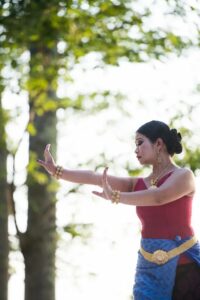
Charya performing Intersections Through Time at her Inside/Out Performance at Jacob’s Pillow, Becket, Massachusetts, 2017 Photo by Christopher Duggan.
That is why our archival projects are decisively ongoing. When I say “ongoing,” I mean in very real time. At the Dance/USA convening in Denver, our “Charya Burt gang” was taking every chance to get lingering work done. In between events, we gathered outside the conference rooms to adjust programs, make graphic user interfaces, and tag new records. And we are still doing that as I’m writing this blog. And that is fine.
Archivists have yet to build a standard tool for preserving dance works or other performance arts, not to mention community-based performance art archives. Existing archives and institutions are not working for all people. Those archives are not catching the expressions, sensations, feelings and tensions that people are living, day in and day out. There are gaps of distrust and disinterest that can only be bridged if archivists reorient their work. You feel the gap when you run into a system that does not take into account things that you treasure. And you feel the gap when a speech transcription service cannot understand your words. Every Fellow’s project is a new take on that missing piece, on the work of care that is long overdue for the archival world.
That is where we are standing today. That is why we are doing what we are doing. And that is why we will still do it for the foreseeable future. Along that road we may even infuriate one or two traditional archivists. But that is fine. And we will carry on.
Top image: Charya Burt leading a community engagement workshop with the Wat Khmer Modesto Dance Group. Photo by Rob Burt. All photos courtesy of Charya Burt Cambodian Dance.
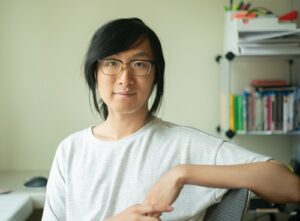 Lingyu Wang (he/they) is a doctoral student in the School of Information and Library Science at University of North Carolina at Chapel Hill. His ongoing research looks at social movement archiving in Hong Kong, Mainland China, and beyond. He received a B.A. in Film and a B.S. in Computer Science from University of California, Berkeley, as well as a M.A. in Media, Culture, and Communication from New York University. Previously, he worked at the Media Resources Center at UC Berkeley, and served as graduate assistant at NYU Libraries’ Scholarly Communications Office. He has also extensively worked in film and stage productions.
Lingyu Wang (he/they) is a doctoral student in the School of Information and Library Science at University of North Carolina at Chapel Hill. His ongoing research looks at social movement archiving in Hong Kong, Mainland China, and beyond. He received a B.A. in Film and a B.S. in Computer Science from University of California, Berkeley, as well as a M.A. in Media, Culture, and Communication from New York University. Previously, he worked at the Media Resources Center at UC Berkeley, and served as graduate assistant at NYU Libraries’ Scholarly Communications Office. He has also extensively worked in film and stage productions.
Recent social movements across the globe have propelled Lingyu to study creative, performative forms of activism; people use these highly affective forms to resist erasure and build communities. Lingyu is thus drawn to Charya Burt, whose dances use a rich repertoire of mediums and techniques to discuss similar memories and histories. Together with Charya and her colleagues, he looks forward to pushing the archives’ boundaries to tell better stories and connect people with shared pasts.
____
We accept submissions on topics relevant to the field: advocacy, artistic issues, arts policy, community building, development, employment, engagement, touring, and other topics that deal with the business of dance. We cannot publish criticism, single-company season announcements, and single-company or single artist profiles. Additionally, we welcome feedback on articles. If you have a topic that you would like to see addressed or feedback, please contact communications@danceusa.org.
Disclaimer: Opinions expressed in guest posts do not necessarily represent the viewpoints of Dance/USA.


